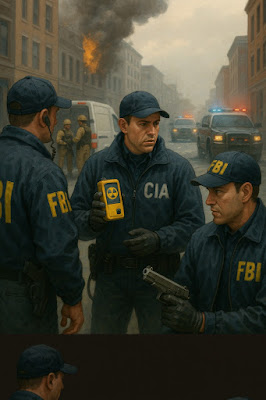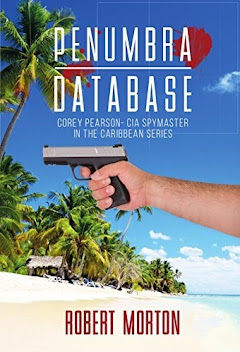 |
| CIA and FBI confront a looming dirty bomb threat. |
Picture
this: you're sipping your morning coffee, half-reading the news on your phone,
when sirens start screaming and your signal dies. People are running—some
crying, some just stunned. No mushroom cloud, no shockwave. Just chaos. Turns
out, someone set off a dirty bomb downtown. Not the end of the world, but
radioactive dust is now clinging to everything—buildings, streets, skin. Whole
blocks are locked down. Hospitals are swamped. And no one knows how bad it
really is yet.
Sounds like a spy novel, right? It’s not.
This is the dirty bomb scenario. And it’s real. Dead real. Terrorist groups
like Al-Qaeda and ISIS have already tried to pull it off. Others still might.
All it takes is a handful of stolen radioactive material and someone desperate
enough to use it.
Take Al-Qaeda. Right after 9/11, intel
picked up chatter that they weren’t just dreaming big—they were getting
creative. Not with nukes, but with something dirtier. A bomb that wouldn’t
flatten a city, but would poison it. In 2002, an American named Jose Padilla,
one of their guys, got picked up before he could pull the trigger on a dirty
bomb plot inside the U.S. He never built the device—but that wasn’t the point.
The plan was real. Spread radiation. Spark panic. Shut down daily life with a
single blast of fear.
Then came ISIS. When they rolled through
Iraq and Syria, they didn’t just take towns. They raided hospitals and science
labs, looting vials of cesium-137 and cobalt-60—the kind of stuff used to fight
cancer or run machines, but deadly if rigged into a bomb. By 2016, Britain’s
security chiefs were sounding alarms: ISIS had enough material and know-how to
piece together a dirty bomb. One question hung in the air—where would they
light it up? Odds were, a Western city would be the bullseye.
It’s not just the Middle East, either. In
1995, Chechen rebels buried a container of cesium-137 in a Moscow park and
called the press. They never set it off, but the message was clear: they knew
how to scare the hell out of people using radioactive waste. And that’s what a
dirty bomb is all about—not mass casualties, but mass hysteria.
Even the doomsday cult Aum Shinrikyo—the
same group behind the Tokyo subway sarin gas attack—tried to develop
radiological weapons back in the ’90s. They had money, scientists, and an
obsession with apocalyptic violence. They never succeeded, but they came
alarmingly close.
These weren’t isolated flukes. They were
early warning signs. And here's the kicker: there are still tons—literally
tons—of radioactive materials floating around the world, poorly guarded or
completely unaccounted for. We're talking about medical isotopes, industrial
devices, abandoned nuclear facilities. According to the International Atomic
Energy Agency, there have been hundreds of cases of missing or stolen
radioactive material over the past two decades. In many cases, no one ever
figured out where it went.
So how tough would it be for a
terrorist—or even some twisted loner—to pull off a dirty bomb attack? It wouldn’t
be that tough. This isn’t a high-tech nuclear warhead we’re talking about. No
need for uranium refinement or lab coats and centrifuges. A dirty bomb is
backyard-level dangerous. Just grab some radioactive scrap, rig it to a basic
explosive, and boom—you’ve turned a city block into a panic zone. And guess
what? There’s plenty of that radioactive junk floating around, unguarded and
forgotten.
Here’s the part no one likes to say out
loud: we’re throwing our security dollars at the wrong problems. Billions spent
on border walls and chasing down families in the desert, while the real
threats—guys with a grudge and a Geiger counter—are slipping through the
cracks. Terrorists don’t need to hike over a border with a bomb strapped to
their chest. They can drive it in the front door, packed in the back of a
rental truck, and no one would know until it’s too late.
It’s time to stop playing defense with
blinders on. We’ve got to shift gears—less obsession with chasing migrants and
more focus on the threats that could actually level a city. That means tracking
every scrap of radioactive material like it’s gold. It means cutting deals with
allies, sharing intel, tightening the net. It means putting more trained eyes
and ears inside the agencies that hunt nuclear smugglers before they make it to
our doorstep.
And most of all, it means dropping the
dangerous fantasy that just because it hasn’t happened yet, it never will. The
material’s already out there. The know-how is too. And trust me—so are the
people who’d love nothing more than to see an American skyline glowing for all
the wrong reasons.
Robert Morton is a member of the Association of Former Intelligence Officers (AFIO) and writes about the U.S. Intelligence Community (IC). He also writes the Corey Pearson- CIA Spymaster Series, which blends his knowledge of real-life intelligence operations with gripping fictional storytelling. His work offers readers an insider’s glimpse into the world of espionage, inspired by the complexities and high-stakes realities of the intelligence community.





No comments:
Post a Comment